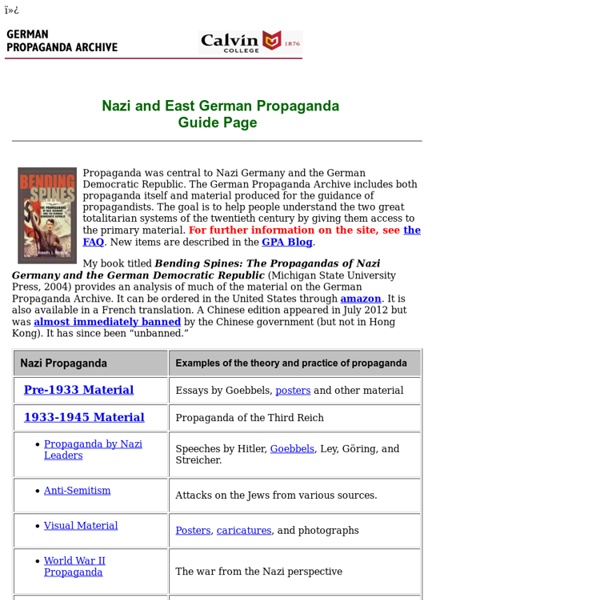Operation CLICK
The Operation CLICK resource book is provided here in PDF file format in 11 separate downloadable files. Files require the Adobe Reader or other PDF reader to view. Get the free Adobe Reader (link opens in a new window)
GHDI - Document - Chapter
X. Literature, Art, and Music print version
Background & Overview of Holocaust Denial
One of the most notable anti-Semitic propaganda movements to develop over the past two decades has been the organized effort to deny or minimize the established history of Nazi genocide against the Jews. In the United States, the movement has been known in recent years primarily through the publication of editorial-style advertisements in college campus newspapers. The first of these ads claimed to call for "open debate on the Holocaust"; it purported to question not the fact of Nazi anti-Semitism, but merely whether this hatred resulted in an organized killing program. A more recent ad has questioned the authenticity of the U.S.
JCS Online Resources
The acclaimed Churchill Archive is now free for the first time to schools worldwide thanks to a $1 million donation from philanthropist Laurence Geller CBE. "All children should understand Sir Winston Churchill’s fundamental place in our nation’s history,” says the Rt Hon Nicky Morgan MP, Secretary of State for Education and Minister for Women and Equalities, "and schools can now seize the opportunity to access the Churchill Archive – a tremendous cache of documents that bring history to life.” Opening up exciting new opportunities for the teaching and learning of History at secondary level, the Churchill Archive - described by History Today as "the real gem of online Churchill resources" - offers cross-searchable online access to over 800,000 original documents. Highlights include: OVER 370 SCHOOLS HAVE REGISTERED FOR FREE ACCESS...HAS YOURS? Click here to find out!
Music Approved of by the Third Reich
Under the Nazi regime, all music produced had to fit within certain standards defined as "good" German music. Suppression of specific artists and their works was common, yet musicians were permitted limited artistic freedom. The Nazis attempted to create a balance between censorship and creativity in music to appease the German people. This blend of art and politics led to a three-prong policy regarding musicians and artists: Loyal Nazi members who were talented musicians were guaranteed a job. Loyal Nazi members who were not talented musicians were not guaranteed a job. Any non-Jewish person who demonstrated a "genius" for music and was a member of the Reichsmusikkammer (Reich Music Chamber) was permitted employment.
Lebensraum: Policy or Rhetoric?
When the Germans talked of Lebensraum, or ‘living space’, they used the term to denote a perceived need to have enough physical room to provide for themselves comfortably. In particular, it identified the possession of enough land to feed a population large enough to ensure Germany a place on the world stage. Hitler did not just start talking about the need to conquer Lebensraum in 1941; its origins lay much further back than even 1939. Anti-Nazi newspaper columnists (for example in Der Deutsche in Polen) observed during the late 1930s that Hitler’s foreign policy involved something more than just planless initiatives, improvisation and contradictory imperatives.
Degenerate Art
The years 1927-37 were critical for artists in Germany. In 1927, the National Socialist Society for German Culture was formed. The aim of this organization was to halt the "corruption of art" and inform the people about the relationship between race and art.
Who were the Black Diggers?
Nearly 4,000 Indigenous people officially served during World War II (1939-1945), according to historian Robert Hall. Of those, about 3,000 were Aboriginal people and 850 Torres Strait Islander people. Other accounts suggest as many as 5,000 Indigenous people served. The War Service Land Settlement Agreement between the Federal Government and states resulted in soldier settlement legislation that granted returned service personnel land. While Indigenous service personnel were not excluded, many say they were rejected from the scheme.
Culture in the Third Reich: Overview
The "Synchronization" of Culture In 1933, Nazi Minister for Popular Enlightenment and Propaganda Joseph Goebbels began the synchronization of culture, by which the arts were brought in line with Nazi goals. The government purged cultural organizations of Jews and others alleged to be politically or artistically suspect. The works of leading German writers such as Bertolt Brecht, Lion Feuchtwanger, and Alfred Kerr were consigned to flames in a book burning ceremony in Berlin. The Reich Culture Chamber
‘Too Dark to See’ documentary sheds new light on black diggers
This year, Western Sydney University and the Australian War Memorial are correcting the record with the documentary, ‘Too Dark to See’. But the project is not just a film - it also includes a photographic exhibition and a commemorative book, published in time for Remembrance Day. The works celebrate Indigenous soldiers by recounting their personal stories. Melissa Williams from Western Sydney University’s Office of Aboriginal & Torres Strait Islander Employment & Engagement, told NITV the film “is to commemorate Aboriginal and Torres Strait Islander people and really to honour their contribution.”



